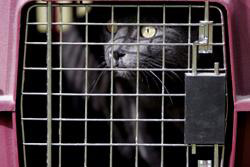Necessary Supplies

Before bringing your cat home, you should be prepared with some supplies. It's best to have all supplies ready before the first time your new pet enters the house, because he/she should be able to immediately begin exploring and getting used to things. He/she shouldn't have too many major changes made to his/her surroundings during his/her first days at home.
Cat Carrier
The first thing you will need is a cat carrier. This purchase will likely be one of your first, as you will need to put the cat in a carrier for his/her trip home. It should be safe and sturdy with plenty of ventilation and easy access for you. A cardboard box does not allow for enough air access, and a scared cat could probably claw its way through it. A plastic carrier with a lockable door on the front should be sturdy enough and also provide the right amount of accessibility. Cover the bottom with a towel or another piece of soft material before placing your cat inside.
Food and Water Bowls
Your cat should have food and water bowls waiting for him/her upon his/her arrival. There are several kinds of bowls available, but earthenware or ceramic are the safest. The bottoms of the bowls should be weighted to avoid tipping. If you've adopted a kitten, you should consider purchasing smaller, shallower bowls that are designed especially for kittens. Bowls should be cleaned daily and placed far from the litter box, as cats do not like to eat and relieve themselves in the same location.
Food
There are several types of foods to choose from when deciding what to feed your cat. If possible, find out what kind of food the breeder, shelter, or petshop was feeding your cat and stick to the same diet for a while. He/she will be adjusting to so many new things during his/her first few weeks at home that keeping his/her diet the same may be a comfort to him. What you feed your cat also depends on his/her age: kittens need a special diet and senior cats will also require a diet formulated especially for seniors.
Cat Bed
Many cats will happily fall asleep anywhere, but a cat bed will be a favorite napping spot. The bed should be warm and soft, and it should be located in a place that makes your cat feel comfortable and safe. Make sure it is large enough for your cat to lay down in it and have some room to stretch, but small enough to allow him/her to feel secure.
Litter Box
There are many different styles of litter boxes available today. A self-cleaning litter box has a mechanism that will rake the dirty litter after your cat has used the box. While some owners appreciate the cleaning help this offers, these boxes are quite expensive and the mechanism can sometimes frighten the cat.
A hooded litter box has a tall cover that is meant to give the cat some privacy while hiding the mess often found in litter boxes. This can also be a great help in keeping litter from being tossed over the edge of the box and on to the floor. However, some cats are afraid of the hood and will not use a litter box that is enclosed. Hooded boxes can also develop a harsh odor because of a lack of ventilation.
The third litter box option is a just a plain plastic box with cat litter inside. Many cat owners prefer this simple option, but it does require the most maintenance to keep it looking tidy and smelling fresh.
Scratching Post
Cats need to scratch, so why not buy them a post that's made for scratching? Make sure the post has a sturdy base to keep it from tipping over. It should be at least as tall as the cat so he/she can stand on his/her hind legs and get a good stretch while he/she's scratching. If you have more than one cat, you should have at least one scratching post per cat.
Toys
Cats love to play, so you'll need to provide your cat with a variety of safe toys. Pouncing is a favorite activity of cats, so balls and catnip-filled mice are good options. To avoid the danger of your cat choking on a piece of a toy, do not give him toys that have small parts that can be torn off, such as bells, feathers, or pom-poms. Examine all toys before letting your cat play with them, and make sure to regularly inspect the toys he plays with so you can replace those that are worn or broken.
Collar and ID Tag
Your cat should wear a collar with an ID tag at all times. The tag should have your name, address, and telephone number on it. The collar should have an automatic release that will disengage if your cat gets stuck on something, like a tree branch. Make sure the collar fits properly and won't irritate your cat's neck or affect his breathing and swallowing. A general rule is to allow enough room for two fingers to fit between the collar and the neck.
The first few days at home will be an exciting time for you and your cat. You will learn a lot about each other and begin to build a relationship. He/she should soon start to get comfortable in his/her new surroundings and begin using the supplies you've bought him/her. Over time, he/she will become less and less like a new pet and more and more like a member of your family.